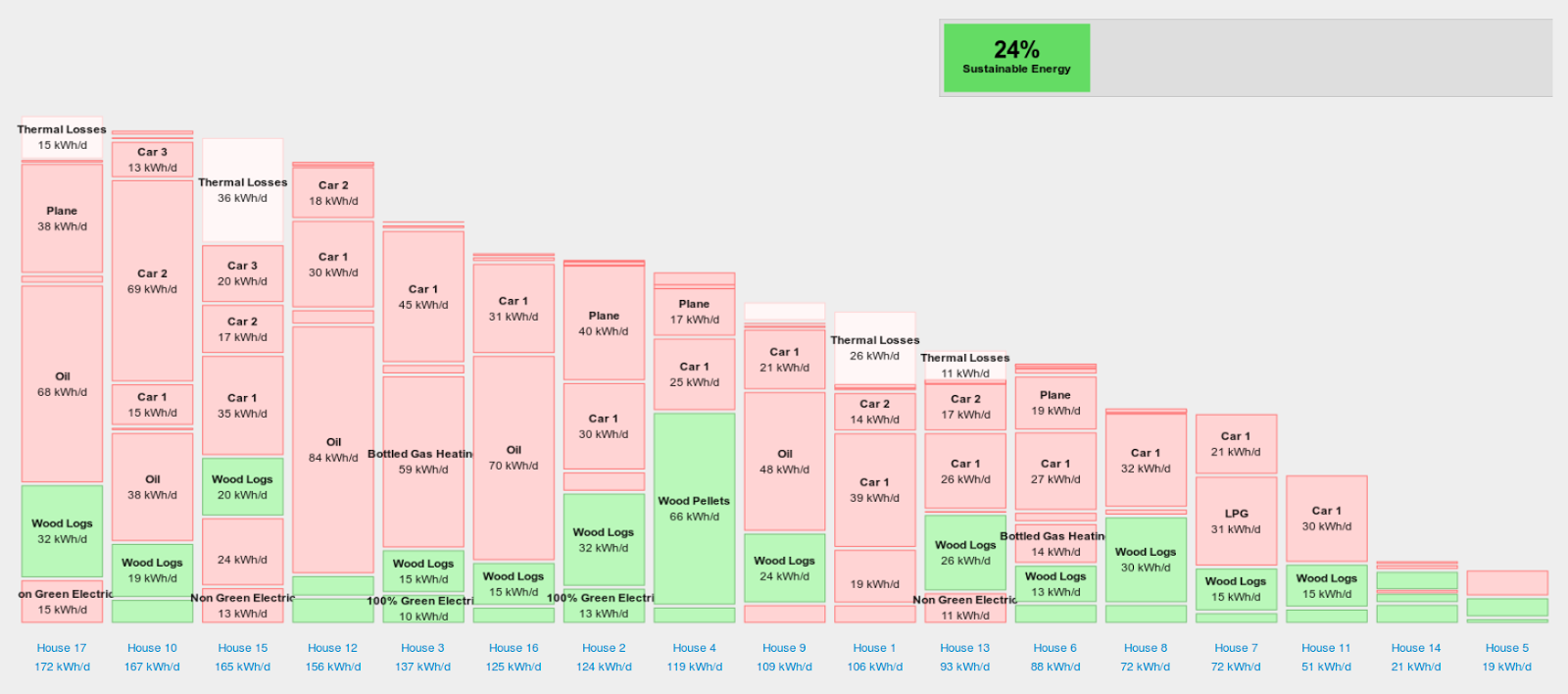Snowdonia household energy study, exploring zero carbon solutions
We looked at the energy used by each household for electric, heating and transport and what the effect would be of applying the solutions outlined in both ZeroCarbonBritain and Sustainable energy without the hot air, visualising the result using David MacKay's energy stack graphics.
I've been looking again at this work recently as I find it a really useful and tangible way of looking at the energy problem and I've taken the opportunity to improve the energy stack graphic visualisation and put it up online here:
Dynamic visualisation:
http://egni.ecobro.org/data
The code for it is open source and on github here:
https://github.com/TrystanLea/energystacks
Here's a brief run through of what you can see:
Current Energy Use
This first graphic shows each households current energy use and where that energy is used:
24% of the energy used by the households come from renewable sources, whether biomass or 100% green electricity tariffs. The wide range of total energy use per household is quite interesting, using the dynamic tool you can explore the contribution of occupancy and floor area. You can also look at C02 and energy cost per household.
Solutions for reaching 100% sustainable energy for household electric, heating and transport.
In both the ZeroCarbonBritain report and David MacKay's Sustainable Energy without the hot air, building retrofit (insulation and air-tightness), heatpumps and electric vehicles form the cornerstone's of both significantly reducing the amount of energy we need to provide the same amount of comfort/utility and making it possible to power the remaining energy demand from electricity generated by sustainable energy.
The following graphics show's what the effect would be if each household in the study applied these measures:
1) All households switch current electric consumption to a 100% Green Electricity tariff:
2) 100% green electric powered heatpumps, Biomass and electric cooking instead of oil, gas and coal. For heatpumps it assumes replacing existing heat input with a heatpump with a COP of 3.0. See step 5 for a very basic application of building performance retrofit work.
Heatpumps form the cornerstone of supplying the remaining heat demand after retrofit in both Zero Carbon Britain and David MacKay's sustainable energy without the hot air. The performance of a heatpump is highly dependent of course on being designed, installed and controlled correctly.
3) Switch all petrol and diesel cars to electric cars powered by renewable electricity (Assuming mileage stays constant and an electric car performance of 4.0 Miles/kWh)
The ZeroCarbonBritain report from CAT suggests a reduction in the number of miles driven through a combination of increased use of pubic transport, walking, biking and better planning of where we live in relation to work/activities in addition to a switch to electric vehicles which are both more efficient than petrol and diesel cars and can be powered by renewable electricity.
4) Electric trains instead of planes:
In order to achieve the last 15% and still enjoy travelling long distances we would need a switch from flights to electric train journey's, the model here just assumes that the number of flight miles are replaced with electric train miles powered by renewable electricity and that the destination is reachable by train.
5) At least 120 kWh/m2.year primary energy for space heating and home electric.
Improving the thermal performance of buildings by adding insulation and improving the air-tightness should be one of the first measures applied and considered before or at the same time as any heating system changes as in step 2 above. The implementation of applying retrofit measures in the energy stack visualisation model here is only to set a maximum primary energy use requirement rather than to explore what's possible on a house by house basis which would give a better picture of the potential savings from retrofit work.
Powering Up with Renewable Energy
The ZeroCarbonBritain report goes into a lot of detail on how the remaining energy demand after applying power down measures can be supplied by renewable energy and also the need for storage technologies to manage the intermittent nature of a fully renewable energy supply. We didnt look into this as part of our study but it would be interesting to explore it in more detail in the future to answer questions such as: what scale of community energy projects such as community wind, solar and hydro should we be thinking of if we are to supply our energy demands after applying power down measures? and how much should we be thinking about energy storage in a more local context?
There's a lot of things that could be improved about the study. Rather than applying back of the envelope calculations on the effects of applying the various solutions to each house it would be better to look at each house in detail, carrying out a full detailed Carbon Coop home energy assessment for each house on how energy demand can be reduced by up to 70% through retrofit work.
Related links
OpenEnergyMonitor page on Sustainable Energy:
http://openenergymonitor.org/emon/sustainable-energy
The ZeroCarbonBritain report:
http://zerocarbonbritain.org/
Alice Hooker-Stroud, Centre for Alternative Technology, ‘Zero Carbon Britain (Energy)’
Sustainable energy without the hot air
http://withouthotair.com/
Carbon Coop
Charlie Baker's talk about carbon coop and 80% retrofit at the radical emissions reduction conference
Where next?
I would be interested to hear any thoughts on how to develop this work further, where it should go next. Feel free to email me if you have any ideas or would like to discuss: trystanlea at openenergymonitor.org To engage in discussion regarding this post, please post on our Community Forum.





